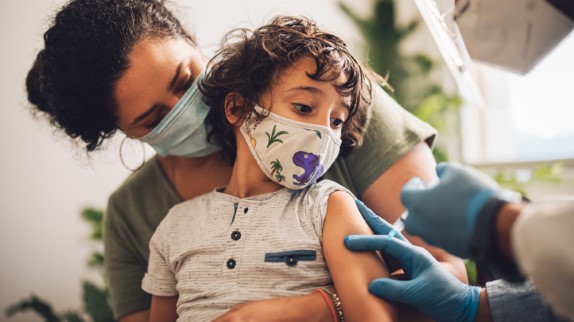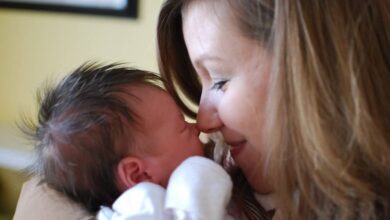The Omicron Variant and Kids

If you have a baby or other small children at home, you’ve been following the news about the dominant variant of COVID-19, Omicron, and its subvariants with some special concerns.
Although COVID-19 infections are typically milder in children and infants, the Omicron outbreak contributed to a record number of pediatric cases and hospitalizations last winter and continues to cause spike in children contracting the virus since then.
Here’s what we know about the Omicron variant of COVID-19 in children and what you can do to protect your family.
How does the BA.5 variant affect children?
The Centers for Disease Control and Prevention (CDC) announced the first US case of Omicron variant on December 1, 2021. Since then, it has tracked the spread of its subvariants — the slightly different but related strains within the Omicron family.
In December, January and February of 2022, the BA.1 subvariant accounted for the majority of cases in the country. Then another subvariant called BA.2 took over in the spring. Now, BA.4 and BA.5 account for more than 90 percent of cases in the US[1]
Experts expect viruses to evolve and new variants to emerge. Reducing the spread of COVID-19 may help slow this process. For now, the advice remains the same: Get yourself and children older than 6 months (and, in the case of those 5 and older, boosted) vaccinated against COVID-19.
The US Department of Health and Human Services (HHS) has purchased booster shots that specifically target the BA.4 and BA.5 Omicron subvariants.[2]
The FDA has approved these multi-strain Omicron boosters for emergency use, and the CDC has also given them the green light.[3] Children age 5 and older, as well as adults, will get the Pfizer version, while everyone age 6 and older will receive the Moderna version.
Those who want these updated boosters can get them at least two months after the primary or booster vaccination, according to the FDA. The new bivalent vaccines contain two parts of the COVID-19 mRNA, one based on the original strain of the virus and the other adapted to the BA.4 and BA.5 lineages of the Omicron variant.
Appropriate masks — for people over 2 years of age — also offer protection against all variants.
What are the symptoms of the Omicron variant in children?
The CDC says symptoms of COVID-19 may include:
- Fever
- Trembling
- Cough
- Shortness of breath
- Fatigue
- New loss of taste or smell
- Muscle or body pain
- Headache
- Sore throat
- Congestion or runny nose
- Nausea
- Diarrhea
In general, the symptoms of the Omicron variant are very similar to those of the Delta variant, says William Schaffner, MD, an infectious disease specialist at Vanderbilt University Medical Center in Nashville, Tennessee.
Because these symptoms mimic the common cold, if your children experience any of them, you should get them tested for COVID-19 and isolate them until you get the results, Robert said. McGregor, MD, Chief Medical Officer of Akron Children’s Hospital in Akron, Ohio.
Does the Omicron variant cause more severe pain in children?
In general, Omicron causes less severe disease than earlier variants, but it is also more contagious than the original COVID-19 virus and the Delta variant.
“This is the most contagious virus we’ve seen since measles,” said Rajeev Fernando, MD, an infectious disease specialist and member of the What to Expect Medical Review Board. More than 14.8 million children have been reported to have tested positive for COVID-19 since the pandemic began, according to the American Academy of Pediatrics (AAP), citing available state data.
Since a vaccine was approved for the age group 5 to 11 in November 2021, about 38 percent of children in that group received at least one dose and about 31 percent received two doses, according to in AAP immunization report in children. Vaccines for children ages 6 months to 4 years were authorized for emergency use in June 2022, and so far about 9 percent of that age group has received a dose.
Can the Omicron variant cause croup?
Croup — a respiratory condition characterized by a harsh, barking cough — is one of the most common conditions seen in the pediatrician’s office. And several different viruses, including COVID-19 and the flu, can cause inflammation in the upper airways.
Researchers documented cases of croup associated with COVID-19 early in the pandemic, but the Omicron variant led to more reports. Symptoms of croup include:
- Barking cough that feels like a seal and is usually worse at night
- Hoarse, raspy voice
- Swollen or runny nose
- Difficulty swallowing
- Irritability
- Fever
- Shortness of breath
The good news is that pediatricians have enough experience in treating this disease. Your child’s doctor may prescribe steroids, but the pain will usually go away with the right home remedies, such as using a humidifier, getting fresh (cool) air outside and keeping your child hydrated.
Call the pediatrician if you notice any of the following signs:
- Difficulty in breathing, especially during the day
- signs of dehydration, like crying without tears and some wet diapers
- Blue or gray in color around your child’s mouth, nose or fingernails
- stridor, a loud breathing sound, daytime, or nighttime stridor that does not go away immediately when exposed to steam or cold air
- recovery, which is when the skin between the ribs pulls with each breath
- Coughing that do not respond to suggested treatments
How can you protect your children from the Omicron variant?
There are several steps you can take to help keep your family safe from COVID-19, including the Omicron variant:
Get vaccinated
Get everyone in your household 6 months and older vaccinated — and boosted, if they’re eligible. While it’s true that vaccines may not always prevent infection, they are protective against serious illness, says Dr. Schaffner.
The Pfizer-BioNTech and Moderna COVID-19 vaccines caused mostly mild, brief side effects (such as pain where the shot was given and possibly short-term flu-like symptoms) in children, CDC data show. Millions of children have now received their shot, and serious adverse events are rarely reported.
The Pfizer-BioNTech and Moderna COVID-19 booster shots specifically targeting the Omicron variant began rolling out in the US in September 2022, and are now authorized for everyone 5 and over. The CDC expects that currently available vaccines will still offer insurance against hospitalization and serious illness.
Wear a mask
Adults and children over 2 years old can wear masks in public, especially indoors and around other people who are not in their household and especially in areas where the rate of spread of COVID-19.
The AAP still recommends that school and day care students and staff wear face masks regardless of their immunization status when the level of risk in the community is high, although most states, school districts and child care centers removed mask mandates and made wearing them optional.
If your kids can tolerate surgical masks — the best are KF94, N95 and KN95 masks — then those offer better protection than plain cloths, says John Swartzberg, MD, clinical professor emeritus in the division of infectious diseases and immunization at the University of California Berkeley.
Otherwise, opt for cloth masks with layers. “The best protection is a surgical mask with a cloth over it, but it can be difficult for many children to wear for longer periods of time,” says Dr. Swartzberg.
Be careful with the internal settings
Crowded indoor spaces and those without good air circulation are especially dangerous, especially in areas with high rates of COVID-19 transmission.
“It’s a good idea to minimize indoor public spaces as much as possible,” advises Dr. Schaffner. “Watch a movie at home instead of going to the theater, and spend time in an outdoor park instead of inside a children’s museum or play area.”
Try often
If you plan to spend time indoors with anyone outside your household without a mask – such as at a gathering with grandparents – then a quick check of all guests on the day of the event will help, said Dr. Schaffner.
Even if you do that and every test comes back negative, it’s still a good idea to wear a mask inside and open windows if possible, especially if not everyone in the group is fully vaccinated and boosted. Better yet, take the party outside and stick to outdoor gatherings in general if you can.
If you travel, do so safely
Avoid traveling to areas with high rates of COVID-19. If you are traveling with young children, take preventive measures such as wearing a mask (for ages 2 and up) on public transport and when indoors whenever possible, and getting checked before and after traveling. Make sure everyone in your group is fully vaccinated and boosted (preferably recently boosted) if eligible.
Practice good hand hygiene
The whole family should make it a habit to wash their hands frequently with soap and water for at least 20 seconds, especially after being in public, after coughing or sneezing, and before and after caring for someone sick.
If soap and water are not available, adults can use a hand sanitizer that contains at least 60 percent alcohol; infants and young children should not use hand sanitizer.
Follow social distancing guidelines
Because some people without symptoms can spread the virus, stay at least 6 feet (about two arms’ length) from other people when rates of COVID-19 are high.
Was this article helpful?





